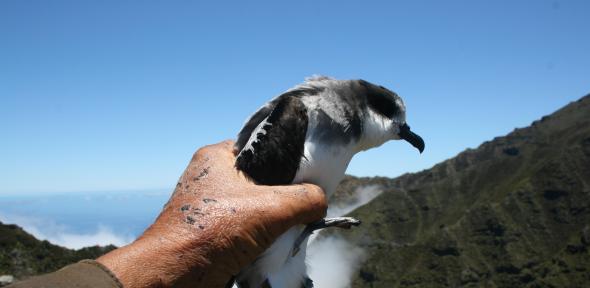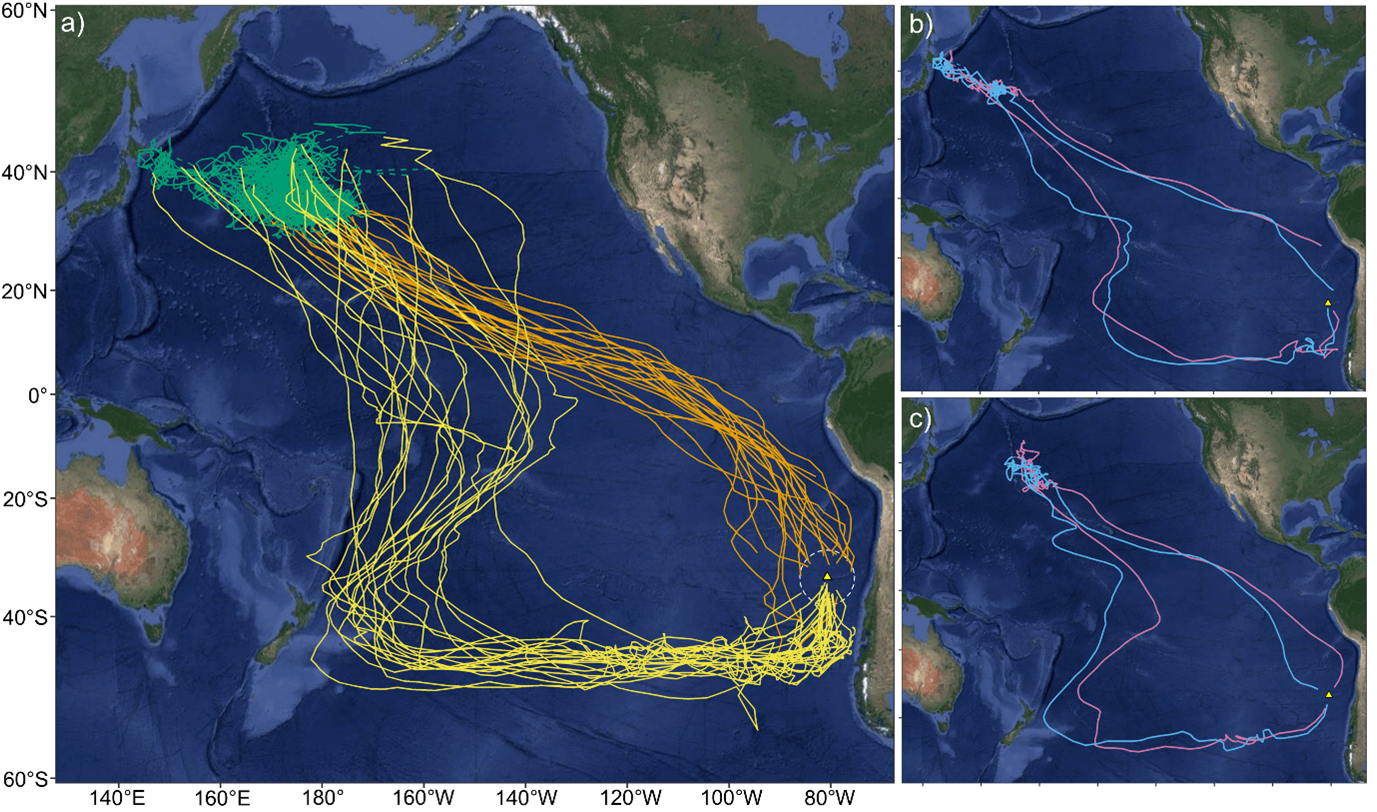
Submitted by L. Bixler on Mon, 19/02/2024 - 08:49
Stejneger's petrel soon to set forth across the Pacific where its movements will be tracked by the tiny geolocator on the right leg.
Studies of bird migration continue to deliver amazing narratives. This is as true of seabirds as of landbirds crossing the Sahara or the high Himalayas. Witness a recent study reporting the 55,000 km yearly travels of a modest grey seabird, Stejneger’s petrel that weighs about 150 g. The species’ entire population, around 100,000 pairs, nests on Isla Alejandro Selkirk in the Juan Fernández archipelago around 700 km west of continental Chile in the eastern Pacific Ocean. Incidentally this archipelago was where the Scottish seaman, Alexander Selkirk, was marooned for four years in the early 1700s. The brouhaha associated with his return to the UK prompted Daniel Defoe to write Robinson Crusoe; hence the current island name.
The study, recently reported in Marine Biology, was undertaken by Tommy Clay, an analyst with the US Environmental Defense Fund, and Michael Brooke of the Department of Zoology. It involved the deployment of 1g geolocators on the birds in January 2020. These devices detect light levels and hence the time of local dusk and dawn, and thus the geographical position of the bird. They also give a wet/dry reading, effectively reporting whether the bird is flying or swimming on the sea.
Fortunately Brooke was able to leave the island before the world closed down for Covid but “I had to plead with the ship’s captain and emphasize that my visa was about to expire and that University students were expecting some lectures. Both were in fact true.” For the next two years, as planned, the birds carried the devices as they voyaged. The extent of those travels was only revealed when Brooke returned to Isla Alejandro Selkirk in January 2022. That journey was through a thicket of Covid-restrictions that meant travel from Heathrow to the island took five weeks. “But I am glad I made the effort and was able to retrieve the devices from the birds still nesting in the same burrows as two years earlier,” says Brooke.
Clay takes up the story. “While during the pandemic I was a sausage that travelled between the fridge and the couch, this seabird migrated more than 55,000 km from Chile to Japan and back across the vast Pacific Ocean!”
After breeding, the northbound migration was rapid via Hawaii, covering 13,700 km over 22 days at 640 km/day. Then followed a three month sojourn in the North Pacific. Flight activity was much reduced; the birds spent about two-thirds of each day on the water. This daily routine probably depended on the birds concentrating in an area of the North Pacific where the sea surface temperature dropped quickly with increasing latitude, a feature linked to relatively high marine productivity.
At the end of the northern summer the petrels’ return journey to the southern hemisphere did not reprise the northbound route. Rather the birds first travelled south and then, when east of New Zealand, turned left to head towards Chile in the Roaring Forties. This indirect route covered 24,000 km over 51 days at 500km/day. “Such a distinctively triangular ‘circuit’ has not been recorded for any other species,” comments Brooke.
Fig. 1. a) Migration routes and non-breeding areas of Stejneger’s petrels Pterodroma longirostris tracked with geolocators over two years from Isla Alejandro Selkirk, Juan Fernández Islands (yellow triangle). The outbound and return migrations and non-breeding movements are shown as orange, yellow and green lines, respectively. Tracks during the autumn equinox when latitude estimation was unreliable are shown by dashed lines and the 500 km buffer around the colony used to define departure on migration is shown by a white dashed circle. b-c) The non-breeding movements of two example individuals in both years of tracking (2020: pink, 2021: sky blue) are shown in two separate panels. Blue shading represents ocean floor depth with lighter shades indicating shallower waters. Maps were plotted using the ggmap R package in the Mercator projection, which stretches regions at higher latitudes.

